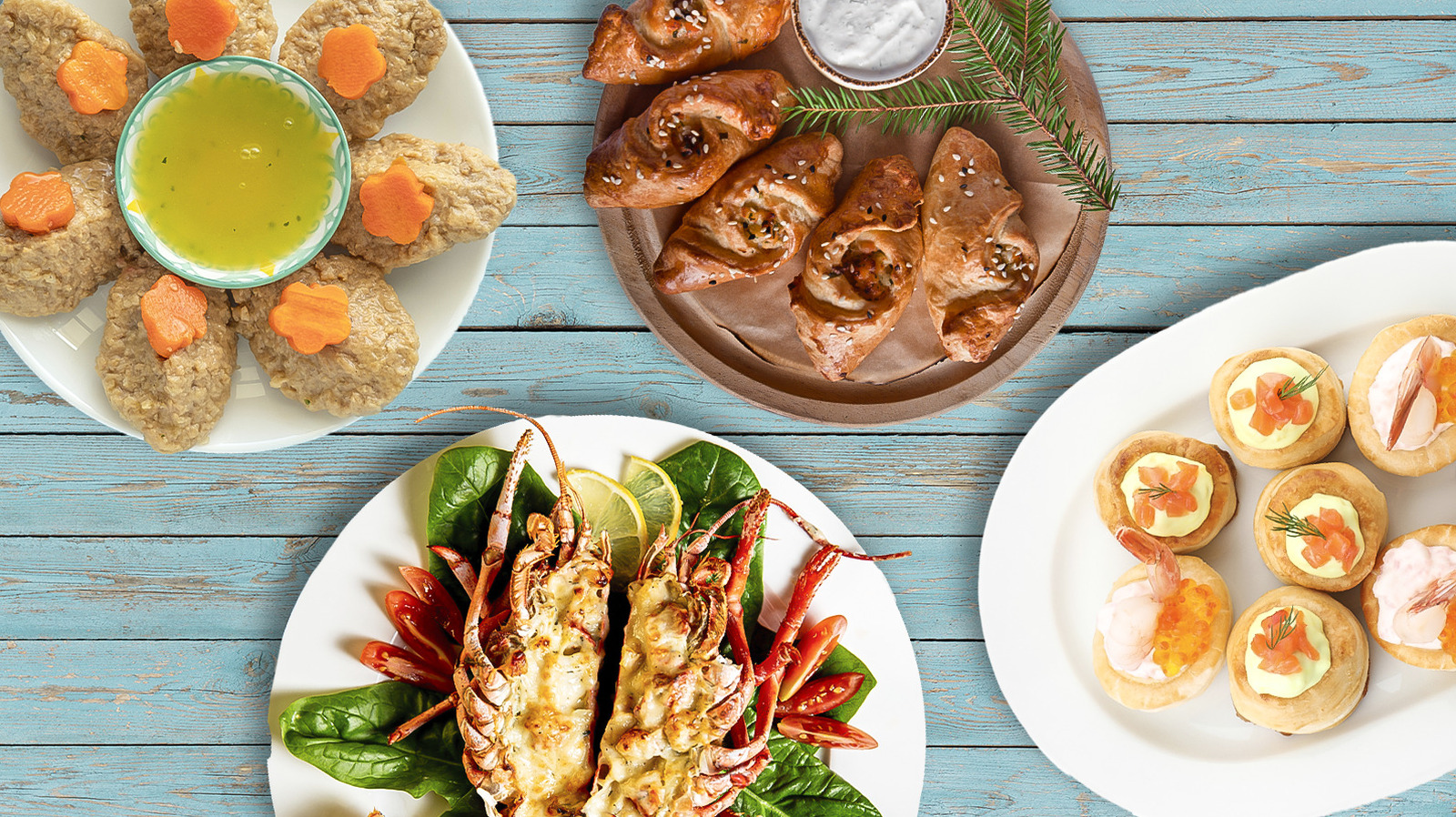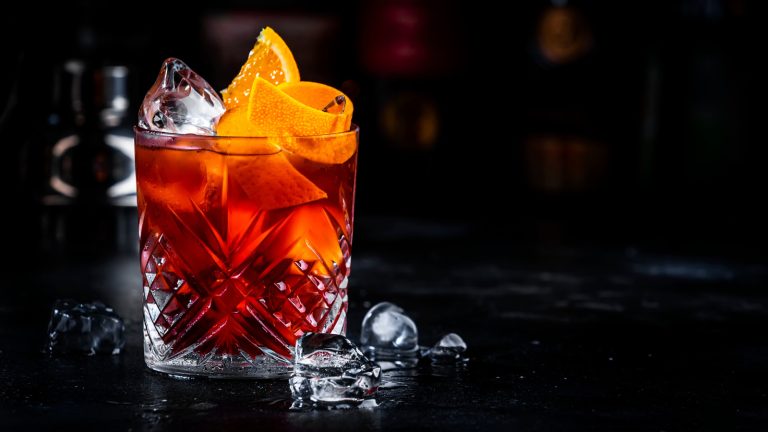Gelfilte fish, sand dabs, coulibiac … no, these aren’t names of the latest Pokémon character release, but seafood dishes from yesteryear. While today we’re accustomed to hamachi collars, whole branzino, and seafood crudos of all kinds, a few generations ago, seafood-centric tables contained dishes we rarely, if ever, see on modern-day tables.
So, what exactly are some of the forgotten fish dishes that Don Draper and Mrs. Maisel would’ve been more than familiar with? We scoured our parents’ vintage cookbooks and the crannies of the internet to fish out 17 lesser-known seafood dishes neglected by most households today.
While some fish dishes fell out of favor due to overfishing, such as orange roughy and grouper, or carry dangerous levels of mercury like the tilefish, we specifically selected dishes that more so fell out of fashion rather than ones that disappeared due to environmental reasoning. In any case, throw on a Sintra record and dip your toe into the delicacies and fishy standards from a bygone era.
Shrimp cream puff
While shrimp’s popularity continues to grow throughout the U.S., so much so that Red Lobster’s “Never Ending Shrimp” offer nearly sank the entire company, today we rarely encounter a restaurant shrimp sans the legendary curved, pink, curved form. But before we associated shrimp with scampi, kung pao, or over-the-top Bloody Mary garnishes, vintage homemakers toiled assembling now odd-seeming shrimp cream puffs.
Essentially, a baked shrimp salad coaxed into a profiterole’s choux pastry, shrimp cream puffs functioned as a high-toned appetizer for parties and celebrations. Chopped cocktail shrimp mingle with mushrooms, onion, celery, and seasoning in a slider-sized canapé, almost like a tuna tartare bite from the annals of time. Time-consuming but probably crowd-pleasing during their time in the sun, tracking down recipes for shrimp cream puffs online yields only a handful of entries. If you happen to find a trove of retro cookbooks, you might luck into a recipe or two from your parents’ generation.
Baked stuffed fish
Today, “stuffed fish” conjures an image of a gutted, whole fish tied together with kitchen twine and filled with herbs, citrus, and spices. But, during past eras, the odd-looking rolled fish filet was a main course for high-toned dinner parties intended to impress.
Resembling a single-serving fish variation of a porchetta or pork roll, serving a baked stuffed fish required patience, multiple steps, and steady hands.
Thinly sliced, boneless fish filets wrap around a filling of greens, aromatics, breadcrumbs, and cheese, then baked for 15 minutes at a high temperature before receiving a squirt of lemon juice and serving. Not an overly complicated dish, baked stuffed fish works best with white, malleable fish like lingcod, sole, or tilapia – all of which take to neighboring flavors well, and don’t contain excess fat like mackerel, tuna, or salmon, which can resist the flexibility needed for assembling the roll. Some variations of baked fish contained crab meat, bacon, and other secondary proteins to help bolster the dimensionality of the dish.
Sole souffle
Pulling off a perfect soufflé is already daunting, but imagining incorporating a fishy element into a dish best known as a dessert adds an extra layer of pressure to the 18th-century French dish. Though sole can still be widely found at supermarkets, whipping the white fish into a puffy egg dish went away along with smoking indoors.
Another recipe that asks its readers to pulverize the fish filets in a blender and whisk the deconstructed fish meat into eggs and cream. To achieve the ideal texture, the mixture passes through a sieve before it’s ready to bake. In single-serving ramekins, the beige-toned fish mousse is to an ovenproof dish where a shallow layer of boiling water awaits. The ramekins bake at a low temperature slowly for about half an hour or until the soufflé’s top rises above its container and its color has darkened to a golden hue. Topped with sauces varying from bechamel, custard, or cream sauce, a sole soufflé carries the fish’s delicate taste along with the airy appeal of a puffed pastry.
Pickled herring in wine sauce
In recent years, a resurgence in tinned fish has succeeded in making a comeback amongst kitchen pantries and picnic baskets. But where current generations peel back the aluminum tab of a tin of herring and eat it alongside crackers, charcuterie, and pickles, households of the past built an entire plate around the tiny, pickled morsels.
Though the pickled Swedish fish has remained a staple for centuries due to its affordability and ease of preservation, the oceanic dish marries the herring’s natural briny flavor with vinegar and dill until the herring cures overnight. Commonly served in Jewish-American households during celebrations around the holidays, though canned versions of pickled herring and wine populate stores, the homemade variation has faded from prominence.
Dressed with a dill-laden wine sauce, the herring is marinated in the refrigerator until cool. Intended as a bite before a larger meal, the dressed-up herring bites can be eaten straight from the plate or atop a cracker.
Coulibiac
Coulibiac, the French pronunciation of Russia’s kulebyaka, is essentially a giant salmon-stuffed pierogi filled with rice and hard-boiled eggs. Created in a puff pastry sized for an entire table, from the exterior, a coulibiac resembles an enormous hand pie or even a Beef Wellington. But instead of meat and mushrooms, the dough encases a now-unusual mixture of grains, baked fish, greens, eggs, and sometimes beets. Though the origins of coulibiac trace back to Russia, it’s France’s fancified interpretation of the encased dish that took off.
Another forgotten dish intended for festivities, coulibiac, though labor-intensive, can be prepped a day before serving, thus freeing up more time to complete side dishes and salads. One of the forgotten dishes that seems primed for a resurgence, the pastry contains no outdated ingredients, and its layers catch the eye when sliced. Colorful, approachable, and ornate, a coulibiac will surely see the light of day again via Instagram thanks to its ability to seize people’s curiosity.
Sand Dabs
Sand dabs are amongst the smallest-sized flounder (or flat fish) we humans eat. At only 3-4 ounces per filleted fish, a single portion per person sits at around 2-4 mini-fillets for each diner, and a plate resembles something between an abundant sole meunier set and high-end fish sticks. A classic menu item at Los Angeles’s oldest restaurant, Hollywood’s Musso and Frank’s (established in 1919), the stalwart fish dish receives a traditional, simple sauce of white wine, capers, and parsley.
Also known as a “common dab,” sand dabs fell out of widespread popularity, perhaps in favor of fish with enough meat to provide a single portion as opposed to the sand dabs’ three to four fillet portions. Though still plentiful all along the West Coast, plates of sand dabs also play into classical tastes still prevalent today – lightly breaded, fish fillets, with a simple sauce. Somehow, the once standard seafood dish slid off modern menus despite their stripped-down allure.
Deviled crab
Once a term widely understood to mean “spicy,” today, a dish receiving the “deviled treatment” most commonly refers to a platter of chilled, deviled eggs. Though the origins of the hard-boiled egg dish date back to ancient Rome, the variation from the American South sees the most recognition on today’s dining tables, deviled foods of all kinds once haunted menus.
Deviled chicken, ham, and crab were once commonplace amongst American recipe collections, though the sole throughline connecting these proteins to the egg widely recognized today is each dish’s contact with spice. Most likely a deviation of a Cuban, Spanish, and Italian immigrant dish, the first known deviled crab recipes seem to originate in Tampa, Florida’s “Cigar City,” after the community of laborers at a cigar factory intermingled family recipes.
In any case, the end result birthed a croquette-like fried morsel filled with crab meat, bell peppers, mayonnaise, and mustard, all bound with egg. Some deviled crab recipes restuff crab shells with the breaded mixture as a nod to deviled eggs’ filled quality. Today, the dish remains mostly relegated to the American South.
Picnic loaf
What might be one of the most outdated old-timey seafood dishes, the picnic loaf’s appearances today are unparalleled. Held in the cradle of an entire loaf of unsliced, white sandwich bread, the picnic loaf is one of the many savory gelatin-based recipes lost to time.
Essentially a hollowed loaf of bread repacked with a mixture of canned fish (often tuna), peas, potatoes, carrots, and hard-boiled egg set into the bread mold thanks to gelatin powder, the picnic loaf looks somewhere like a cross between a pate and a fruitcake.
A relic of a bygone era, the fishy loaf would be served in slices like a premade sandwich after sitting in the fridge for several hours. A cousin of aspic, savory, gelatin-molded dishes popular in the American mid-century, picnic loaves, likely due to their striking appearance, can be found photographed in antique cookbooks, though an edible example of the nearly obsolete dish might prove impossible to track down.
Baked clams
Another canape, baked clams, both served as a vehicle for shellfish and an affordable dish to serve before entrees. Not for the gluten-free folks more common today, baked clams combine cooked, minced clam meat, butter, breadcrumbs, herbs, and parmesan cheese, cooked in a cleaned, halved clamshell.
Though Oysters Rockefeller somehow survived the test of time, trends, and fickle tastes, it’s notably similar to the now rarefied baked clams. Both dishes are stuffed and baked bivalves topped with cheese and breadcrumbs, plated in the shellfish natural vessel. Perhaps due to Oyster Rockefeller’s dependence on keeping the meat intact and simply pressing additional ingredients into their shells before broiling, as opposed to baked clams’ diced approach to presenting the shellfish offering. A variation of New England’s clam casino (which also houses bacon bits), the old-school recipe can easily be found online or even in long-standing East Coast seafood establishments.
Fish loaf
One of the more difficult dishes on the list to plate and photograph in a flattering manner, salmon or other dish loaves, does succeed in embodying exactly what its title suggests. An answer to the less healthy, meatloaf, fish loaf swaps out ground beef and pork for finned fish.
Pressed into a loaf tin, cooked salmon becomes mixed with whisked eggs, herbs, and other stabilizing ingredients such as pulverized Saltine crackers, breadcrumbs, cheese, and butter before it’s baked into a solid slab. Sliced into portions and served alongside classic vegetables, salmon loaf often uses canned, relatively affordable salmon as opposed to the more cost-prohibitive salmon fillets. Intended to stretch a penny while also offering a healthier version of classic Americana, salmon loaf lost its prominence in households as the midcentury came to a close, as did its predecessor, meatloaf, but unlike the heartier, saucier dish, salmon loaf has yet to make a comeback on today’s menus.
Halibut Oscar
Another offshoot of a red meat dish, halibut Oscar takes its cues from a dish that’s invention dates back to 1897, Sweden, when King Oscar II’s resident chef decided to woo the royal figure with a dish comprised of the king’s top three ingredients: veal, asparagus, and crab. Now, though not on most steakhouse menus, the crab and asparagus sit atop a foundation of steak and receive a drizzle of hollandaise before serving.
As the name suggests, halibut Oscar trades in the slab of meat for a fillet of the delicate white fish, topped in the same accoutrements as the originator. Halibut Oscar isn’t entirely extinct, though rarely seen in restaurant settings these days, an internet search will still provide a shortlist of variations on the pescatarian take on an old-school steak-house staple. Surely a notch healthier than steak Oscar, the mild, delicate flavor of halibut likely evades the sultriness of its fattier toppings, causing the dish to stumble out of fashion.
Lobster thermidor
Possibly the most high-end dish from seafood’s recent past, lobster thermidor, was once featured in many sought-after New York restaurants, like the Waldorf Astoria. A treat in every regard, a serving of lobster thermidor would don its recipient with a bisected half of a baked lobster shell containing lobster meat tossed in melted gruyere cheese, cream, and aromatics. Every bit as indulgent as it sounds, lobster thermidor represents one of the cases in which the use of precious lobster meat is somehow elevated above a simple butter and lemon preparation.
But as the annual lobster yield continues to dwindle, so does the expanse of lobster on restaurant menus. And since the dish asks its preparer to kill and cut their crustaceans as opposed to simply carrying home a wrapped fillet, a homemaker’s desire for the clawed delicacy might outweigh the inconvenience.
An occasional special at restaurants like Los Angeles’s Petit Trois, we could see the gooey, shellfish dish make a resurgence in upcoming years as its undeniable appeal proves how, though widely debated, seafood and cheese really can go hand in hand (or claw in claw).
Snapper Veracruz
Snapper Veracruz, with its colorful plating and perky flavor profile, shockingly lost a stronghold on public consciousness despite the dish’s approachability, brightness, and healthiness. A Mexican standard (Huachinango a la Veracruzana) featuring a whole snapper smothered in zesty red sauce, olives, and citrus was adapted to American palates and disassembled into snapper fillets adorned with the same ingredients.
Quick to prepare, vibrant, and nutritious, the decline in snapper Veracruz’s popularity probably lies in the sordid nature of red snapper’s widespread lack of transparency within the U.S. market, as more than half of the restaurants touting the dish on their menu are actually serving another fish entirely. However, now that diners have grown accustomed to family dining and the shareability of whole fish, renditions of the original Mexican touchstone should see a revival on home dinner plates.
Shrimp mousse
Though chicken liver mousse finds its way onto fine dining menus worldwide, the shellfish variety of the appetizer shies away from the spotlight. In fact, the notion of ingesting the whipped shrimp dish feels so archaic that viral TikTok user and YouTuber @bdylanhollis featured shrimp mousse on an episode of his channel, wherein the Generation Z Internet celebrity recreates outmoded recipes from vintage cookbooks.
As he winces his way through recipe description, preparation, and consumption, the social media celebrity confirms how contemporary tastes have shifted since the dish’s invention. From the era of other molded and/or minced seafood creations, the disassembled aspect of shrimp mousse leans away from the fresh seafood that consumers ask for today. Either set into a mold or whipped into a spread, shrimp mousse leans on bread or crackers as a vehicle to deliver its fishy-tasting profile. Though extremely high-end versions of shrimp mousse are served in technique-driven restaurants, the dish has sunk in popularity, perhaps due to consumers’ preference to enjoy the meaty texture of the most popular seafood.
Crab imperial
Yet another mixed and baked seafood recipe, the casserole nature of crab imperial feels like a differently-named warmed crab dip. Named for its dependence on Imperial sauce (mayonnaise, seasoning, and egg), crab imperial united crab meat with the aforementioned sauce in a baked, fatty concoction as indulgent as an ice cream sundae.
Thanks to the cost of crab skyrocketing over the past decade, the baked dish dependent on a healthy amount of crab meat lumps might not be a feasible choice for restaurants looking to stay in the black and home cooks craving the crustacean.
Something of a more crab-heavy crab dip intended for a single person, crab imperial shares many of the elements of a crab dip. Both feature crab, seasoning, and fatty elements, and are quickly baked off before being served warm. The irrelevance of crab imperial simply might be due to the outmoded moniker, as titles like “colonial” and “imperial” fall away from colloquialisms of the current time.
Cod fish balls
Admittedly not the most appetizing titles, cod fish balls appear similar to long-lasting classic dishes like crab cakes. Though the crustacean variety has remained a high-end breakfast staple, especially in the American Northeast, the cod interpretation has lost its widespread visibility.
Essentially just cod-filled fritters, cod balls repurpose cooked cod into piping hot bite-sized nuggets, lovingly hand-molded into miniature spheres. Still conspicuous online, cod ball recipe often consists of mashed, boiled potatoes, cooked cod, eggs, breadcrumbs, and other seasonings. The primary difference between cod balls and a fritter variation lies in the mixture’s dependency on cooked potatoes as opposed to flour and cornmeal to round out the dough, and the shape. The potatoes lend a puffy, light quality to the fried treat. On the other hand, flat, patty-like fritters (and cakes) deliver a denser, less delicate goodie. Served with citrus wedges to calm the fishy quality of the cod, cod ball recipes also often call for a side of thick, fatty, dip like a remoulade to complete the seafood nugget.
Gefilte fish
Finally, the fishy dish widely known by name thanks to an iconic “Seinfeld” episode paying ode to Jewish cuisine, gefilte fish, though a staple of Jewish culture, eludes most gentiles’ craving vocabulary. A mashed fish dish shaped into discs thanks to matzo meal, traditionally served at Passover and during Shabbat when religious practices ban the toils of cooking, cleaning, and burning fire to honor the earth’s creation.
Not requiring any cooking, gefilte fish uses canned, jarred, or pre-cooked fish, thus sashaying the “no fire” rule of Shabbat. The middling taste also remains a punchline of many comedians with Jewish heritage due to its often slimy texture and drab color. Set alongside crackers, carrots, and horseradish, the customary Jewish standard is unlikely to fade from culture’s vernacular, though just as improbable to take the main stage of public consciousness anytime soon. Either way, gefilte fish represents heritage, humor, and an era that has long faded from the Instagram age of food culture.





